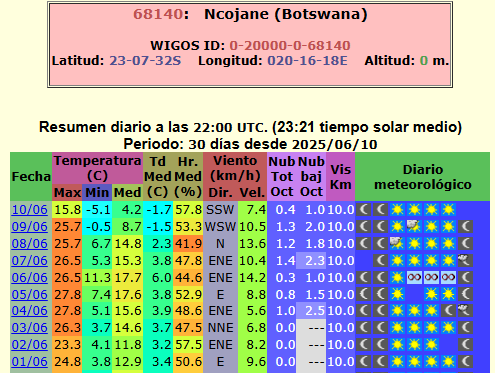
Windhoek, Namibia – June 2025
In an extraordinary event, Namibia’s high-altitude capital, Windhoek, recorded an unprecedented −7.9 °C on a clear winter night in early June 2025. This stunning low marks the coldest temperature ever documented in the city, far below previous historical records and standard climatology.
🧭 Meteorological Synopsis
Windhoek’s climate—classified as semi-arid (BSh)—is known for its sharp diurnal temperature swings, especially in winter. Daytime highs in June usually hover around 20 °C, with average lows near 6–7 °C, and historical record lows at −3.0 °C (June 2011)
However, a potent strong high-pressure system settled over southern Africa, producing:
- Clear, dry winter skies,
- Calm winds,
- Intense nocturnal radiative cooling.
This combination allowed temperatures to plummet well below the previous record, hitting −7.9 °C, a phenomenon requiring an exceptionally cold air pool in conjunction with high altitude and clear conditions.
🌡️ Historical and Climatological Context
| Metric | Value |
|---|---|
| June average low | ~6.5 °C (13 °F) |
| Previous record June low | −3.0 °C (2011, June) |
| New record low | −7.9 °C (June 2025) |
| Temperature anomaly | ~−15 °C below average |
This extreme departure— 4 °C below any prior record all-time low—underscores the unusual nature of this event (all-time record from August is -3,9°C).
🔍 Impacts & Significance
While such frosts are rare in Namibia, especially in the capital, the extreme low could have implications for:
- Urban water systems, which are not designed for freezing nights,
- Agriculture, where winter crops and sensitive plants may suffer damage.
From a climate perspective, this event highlights:
- The variability of winter temperatures in southern African highlands,
- The capacity for extreme radiative cooling under ideal synoptic conditions.
Interestingly, despite rising average global temperatures driven by climate change, brief cold extremes like this remain possible, particularly in continental and high-elevation regions during stable winter nights.
📡 Outlook and Monitoring
Meteorological projections show temperatures will rebound to typical early winter norms, ranging between 5–15 °C by day and 0–5 °C overnight. Still, winter nights in highland Namibia warrant attention for potential cold snaps.
Namibian agricultural agencies and urban planners may review frost prevention strategies—even in Windhoek—to buffer against such rare chill events.
🔚 Conclusion
The −7.9 °C low in Windhoek during June 2025 represents an exceptional outlier in Namibia’s climatic records—an extreme winter freeze previously unseen in the capital. This event is a reminder: even in warming climates, cold extremes can occur, driven by atmospheric dynamics and local geography.
🌡️ Rare Frost at Ncojane, Botswana: –5.1 °C in June 2025
Ncojane, located in northwestern Botswana’s Ghanzi District, recorded a record-setting low of –5.1 °C in early June 2025. This event is remarkably rare for a region with a relatively mild winter climate—demonstrating the potential for significant temperature drops even in semi-arid tropical highlands.
📉 Typical June Conditions
- Average June lows in western Botswana (e.g., Ncojane, Jwaneng) are approximately 4–7 °C, with average highs around 22–25 °C
- Nights below freezing are extremely uncommon and historically unusual in June.
🥶 The –5.1 °C Frost: A Significant Anomaly
- The –5.1 °C low was recorded under clear skies and calm wind conditions, which facilitated intense radiative cooling, allowing surface temperatures to plunge well below freezing.
- Such lows indicate the formation of strong ground frost and hoar frost, potentially harmful to sensitive crops and wildlife in the region.


Source: https://ogimet.com/cgi-bin/gsynext?state=Afr&rank=500&ano=2025&mes=06&day=10&hora=22&Enviar=Ver

Source: https://en.wikipedia.org/wiki/Windhoek

Illustration picture: https://kolarivision.com/infrared-photography-contest/the-namib-desert/



























2 thoughts on “Unbelievable 15°C below Average in Windhoek, Namibia! The Coldest Times ever, -7,9°C (!!!) All-time Records broken by 4°C, Ncojane, Botswana -5,1°C”
Comments are closed.